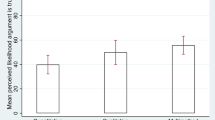Abstract
This study develops a model for controlling social desirability bias in self-report measures. The model incorporates both direct and indirect questioning for a sensitive construct and takes into account method variance of direct and indirect questioning via method factors. The study tests the model with data containing a socially sensitive construct, and finds that the model effectively controls social desirability bias. The rationale for employing both direct and indirect questioning and implications of the findings are discussed.
Similar content being viewed by others
References
Anderson, James C., and David W. Gerbing. (1982). “Some Methods for Respecifying Measurement Models to Obtain Unidimensional Construct Measurement.” Journal of Marketing Research 19 (November), 453–60.
Baggozi, Richard P. (1991). “Multitrait-Multimethod Matrices in Consumer Research.” Journal of Consumer Research 17, March, 426–39.
Bentler, P.M., and Douglas G. Bonett. (1980). “Significance Tests and Goodness of Fit in the Analysis of Covariance Structures.” Psychological Bulletin 88 (November), 588–606.
Blankenship, A.B. (1964). “Some Aspects of Ethics in Marketing Research.” Journal of Marketing Research 1 (May), 26–31.
Boyd, Harper W., Jr., and Ralph Westfall. (1955). “Interviews as a Source of Error in Surveys.” Journal of Marketing 19 (April), 311–324.
Campbell, D. T. and Fiske, D. W. (1959). “Convergent and Discriminant Validation by the Multitrait-Multimethod Matrix.” Psychological Bulletin 56, 81–105.
Cote, Joseph, and M. Ronald Buckley. (1987). “Estimating Trait, Method, and Error Variance: Generalizing Across 70 Construct Validation Studies.” Journal of Marketing Research 24 (August), 315–318.
Crowne, D. P, and D. Marlowe. (1964). The Approval Motive. New York: John Wiley & Sons.
Fisher, Robert J. (1993). “Social Desirability Bias and the Validity of Indirect Questioning.” Journal of Consumer Research 20, (September), 303–315.
Ganster, D.C., H.W., Hennessey, and F., Luthans. (1983). “Social Desirability Response Effects: Three Alternative Models.” Academy of Management Journal 26, 321–331.
Hollenbeck, John R., and Brief, Arthur P. (1987). “The Effects of Individual Differences and Goal Origin on Goal Setting and Performance.” Organizational Behavior and Human Decision Processes 40(3), 392–414.
Hunt, Shelby D., Lawrence B. Chonko, and James B. Wilcox. (1984). “Ethical Problems of Marketing Researchers.” Journal of Marketing Research 21 (August), 309–324.
Johnson, Debra S., and Perlow, Richard. (1992). “The Impact of Need for Achievement Components on Goal Commitment and Performance.” Journal of Applied Social Psychology 22 (21), 1711–1720.
Joreskog, Karl G., and Dag Sorbom. (1988). LISREL 7: A Guide to the Program and Applications 2nd Edition, SPSS Inc.
Kidder, Louise, and Charles M. Judd. (1986). Research Methods in Social Relations, 5th edition, NewYork: The Dryden Press.
Kiecker, Pamela, and James E. Nelson. (1996). “Do Interviewers Follow Telephone Survey Instructions.” Journal of the Market Research Society 38, 2, 161–176.
McGrath, Joseph E., and David Brinberg. (1983). “External Validity and the Research Process: A Comment on the Calder/Lynch Dialogue.” Journal of Consumer Research 10, (June), 115–124.
Nunnally, J. (1978). Psychometric Theory. New York: McGraw-Hill.
Organ, Dennis W., and Ryan, Katherine. (1995). “A Meta-Analytic Review of Attitudinal and Dispositional Predictors of Organizational Citizenship Behavior.” Personnel Psychology 48(4), 775–802.
Peterson, Robert A., and Roger A. Kerin. (1981). “The Quality of Self-Report Data: Review and Synthesis.” In Ben M. Enis and Kenneth J. Roering, (eds.), Review of Marketing, (pp. 5–20), Chicago: American Marketing Association.
———, and Wilson, William R. (1992). “Measuring Customer Satisfaction: Fact or Artifact.” Journal of the Academy of Marketing Science 20, 1, 61–71.
Petty, Richard E., and John T. Cacioppo. (1981). Attitudes and Persuasion: Classic and Contemporary Ap-proaches Dubuque, Iowa: William C. Brown.
Podsakoff, P.M., and D.W. Organ. (1986). “Self-Reports in Organizational Research: Problems and Prospects.” Journal of Management 12, 4, 531–544.
Robinson, Sandra L., and Morrison Elizabeth W. (1995). “Psychological Contracts and Organizational Citizen-ship Behavior (OCB): The Effect of Unfulfilled Obligations on Civic Virtue Behavior.” Journal of Organizational Behavior 16(3), 289–298.
Roth, Julius. (1966). “Hired-Hand Research.” American Sociologist 1 (August), 190–196.
Sudman, Seymour, and Norman M. Bradburn. (1974). Response Effects in Surveys: A Review and Synthesis Chicago: Aldine.
Widaman, Keith F. (1985). “Hierarchically Nested Covariance Structure Models for Multitrait-Multimethod Data.” Applied Psychological Measurement 9 (March), 1–26.
Zerbe, Wilfred J., and Delroy L. Paulhus. (1987). “Socially Desirable Responding in Organizational Behavior: A Reconception.” Academy of Management Review 12 (April), 250–264.
Author information
Authors and Affiliations
Rights and permissions
About this article
Cite this article
Jo, Ms., Nelson, J. & Kiecker, P. A Model for Controlling Social Desirability Bias by Direct and Indirect Questioning. Marketing Letters 8, 429–437 (1997). https://doi.org/10.1023/A:1007951313872
Issue Date:
DOI: https://doi.org/10.1023/A:1007951313872




